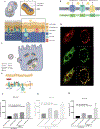Cellular and subcellular optogenetic approaches towards neuroprotection and vision restoration
- PMID: 36503723
- PMCID: PMC10247900
- DOI: 10.1016/j.preteyeres.2022.101153
Cellular and subcellular optogenetic approaches towards neuroprotection and vision restoration
Abstract
Optogenetics is defined as the combination of genetic and optical methods to induce or inhibit well-defined events in isolated cells, tissues, or animals. While optogenetics within ophthalmology has been primarily applied towards treating inherited retinal disease, there are a myriad of other applications that hold great promise for a variety of eye diseases including cellular regeneration, modulation of mitochondria and metabolism, regulation of intraocular pressure, and pain control. Supported by primary data from the authors' work with in vitro and in vivo applications, we introduce a novel approach to metabolic regulation, Opsins to Restore Cellular ATP (ORCA). We review the fundamental constructs for ophthalmic optogenetics, present current therapeutic approaches and clinical trials, and discuss the future of subcellular and signaling pathway applications for neuroprotection and vision restoration.
Keywords: Adeno-associated virus; Mitochondria; Optogenetics; Photoswitch; Retina; Subcellular.
Published by Elsevier Ltd.
Figures












Similar articles
-
Advances in Ophthalmic Optogenetics: Approaches and Applications.Biomolecules. 2022 Feb 8;12(2):269. doi: 10.3390/biom12020269. Biomolecules. 2022. PMID: 35204770 Free PMC article. Review.
-
Opsins for vision restoration.Biochem Biophys Res Commun. 2020 Jun 25;527(2):325-330. doi: 10.1016/j.bbrc.2019.12.117. Epub 2020 Jan 23. Biochem Biophys Res Commun. 2020. PMID: 31982136 Review.
-
Optogenetic Strategies for Vision Restoration.Adv Exp Med Biol. 2021;1293:545-555. doi: 10.1007/978-981-15-8763-4_38. Adv Exp Med Biol. 2021. PMID: 33398841 Review.
-
Optogenetics.Curr Opin Ophthalmol. 2015 May;26(3):226-32. doi: 10.1097/ICU.0000000000000140. Curr Opin Ophthalmol. 2015. PMID: 25759964 Free PMC article. Review.
-
Optogenetic Therapy for Visual Restoration.Int J Mol Sci. 2022 Nov 30;23(23):15041. doi: 10.3390/ijms232315041. Int J Mol Sci. 2022. PMID: 36499371 Free PMC article. Review.
Cited by
-
Bridging the gap of vision restoration.Front Cell Neurosci. 2024 Nov 21;18:1502473. doi: 10.3389/fncel.2024.1502473. eCollection 2024. Front Cell Neurosci. 2024. PMID: 39640234 Free PMC article. Review.
-
Regulatory aspects of optogenetic research and therapy for retinitis pigmentosa under EU law.Front Med Technol. 2025 May 9;7:1548927. doi: 10.3389/fmedt.2025.1548927. eCollection 2025. Front Med Technol. 2025. PMID: 40417352 Free PMC article. Review.
-
The ABCs of Stargardt disease: the latest advances in precision medicine.Cell Biosci. 2024 Jul 26;14(1):98. doi: 10.1186/s13578-024-01272-y. Cell Biosci. 2024. PMID: 39060921 Free PMC article. Review.
-
Recently Approved Drugs for Lowering and Controlling Intraocular Pressure to Reduce Vision Loss in Ocular Hypertensive and Glaucoma Patients.Pharmaceuticals (Basel). 2023 May 26;16(6):791. doi: 10.3390/ph16060791. Pharmaceuticals (Basel). 2023. PMID: 37375739 Free PMC article. Review.
References
-
- Adamantidis A, Arber S, Bains JS, Bamberg E, Bonci A, Buzsáki G, Cardin JA, Costa RM, Dan Y, Goda Y, Graybiel AM, Häusser M, Hegemann P, Huguenard JR, Insel TR, Janak PH, Johnston D, Josselyn SA, Koch C, Kreitzer AC, Lüscher C, Malenka RC, Miesenböck G, Nagel G, Roska B, Schnitzer MJ, Shenoy KV, Soltesz I, Sternson SM, Tsien RW, Tsien RY, Turrigiano GG, Tye KM, Wilson RI, 2015. Optogenetics: 10 years after ChR2 in neurons--views from the community. Nat. Neurosci. 18, 1202–1212. - PubMed
-
- Aisenbrey S, Lafaut BA, Szurman P, 2002. Macular translocation with 360 retinotomy for exudative age-related macular degeneration. Archives of. - PubMed
Publication types
MeSH terms
Grants and funding
LinkOut - more resources
Full Text Sources

